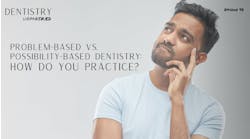Nothing is more important to parents than the safety, health, and comfort of their children. This gives pediatric laser dentistry a unique opportunity to assuage the fears of parents, 75%1 of whom had a negative experience with a dentist as a child, and to create a whole new generation of patients who aren’t afraid of the dentist. What I’m talking about is a paradigm shift, and it’s taking shape using laser dentistry for everyday procedures like fillings and crowns, as well as for increasingly common procedures like frenectomies.
While the total number of newborns diagnosed with tethered oral tissues (TOTs) such as tongue- and lip-ties remains steady at about 5%2 for tongue-ties and 11%3 for lip-ties, the number of both lingual and maxillary labial frenectomies has been surging. In turn, diagnosis and treatment plans have spiked in recent years, with 77%4 of pediatric dentists reporting they have seen an increase in frenectomy referrals in the last five years.
You may also be interested in ... Jumping to the future of dentistry with the Solea 9.3 µm all-tissue laser
Not surprisingly, awareness of the negative health impacts of TOTs is also increasing among physicians and parents. For example, TOTs may hinder a newborn’s ability to properly latch during breastfeeding. TOTs can also cause infants to struggle to gain weight and become more prone to irritability and colic. Just as concerning to parents are the long-term negative consequences of TOTs, if left untreated. Children with TOTs are more prone to sleep apnea and other breathing difficulties and can have trouble with speech and language development. This presents a valuable opportunity for pediatric dentists to make a positive, lasting impact on the well-being of their smallest patients, and to create loyalty and preference among parents.
The need for a new approach
Although frenectomies are a straightforward procedure with little risk of complications, the procedure has its own set of challenges. More specifically, traditional methods may be prone to excessive bleeding, incomplete release, or excessive reattachment, especially if a post-op care routine is not followed by parents. If anesthesia is used, there is also the risk of an allergic reaction or other complications, which contributes in part to the apprehension that parents experience when it comes to using anesthetic on their young ones.
The combination of these factors makes it crucial for pediatric dentists to have the tools and technology to prevent negative outcomes, and laser technologies are an effective solution. However, when choosing new technology for your practice, it’s important to understand that not all lasers are created equal.
In my experience, I have found that the Solea All-Tissue Dental Laser is most effective. What makes it stand out is its ability to deliver the perfect wavelength for both hard and soft tissue procedures. This means procedures like frenectomies can be completed with little to no bleeding and a shorter recovery time than with diode and erbium lasers. In my practice, using this laser for frenectomies and other delicate procedures has resulted in the following outcomes.
No more choosing between quality or quantity. Every dentist strives to deliver an exceptional experience for their patients. But when schedules and appointments stack up, maintaining quality and patient experience standards can become a concern. Waiting for anesthesia and ensuring a patient is comfortable is a crucial part of the job, but it’s easy to feel as if you’re scrambling from procedure to procedure. The Solea laser requires very limited prep time, if any, and the procedure can be done efficiently. This has allowed me to serve more patients without decreasing quality of care. As a result, newborns and my older patients experience less pain and discomfort, and parents are happy and satisfied. We have also seen fewer cancellations and improved postprocedure compliance with follow-up care.
Infants don’t require injectable anesthetic, which results in fast recovery. Anesthesia or numbing with pediatric patients is a significant source of anxiety for parents, and it can increase recovery time for very young patients. With Solea, newborns can resume nursing right away postprocedure, typically with improved latch. For mothers who may be dealing with pain, discomfort, or frustration stemming from breastfeeding, the immediate improvement makes all the difference in the world.
Little to no bleeding. With either a maxillary labial or lingual frenectomy, bleeding can be a common occurrence when using a scalpel or inferior laser technology. This can be disconcerting to parents of young children and a source of frustration for your team. Diode lasers are known to contribute to excessive scar tissue due to the thermal damage to the tissues. Meanwhile, erbium lasers can cause excessive bleeding and a longer healing period.5
Conversely, the Solea laser penetrates deeper into the soft tissue at a depth greater than the width of the blood vessel, so it remains closed off. Not only does this enhance the patient experience, but it allows a clearer surgical field for the dentist and a streamlined procedure. The result is little to no bleeding or inflammation and minimal scar tissue.
Long-term patient preference and retention. Seeing parents of infants and older children leave our practice with big smiles on their faces is extremely rewarding. Plus, this satisfaction makes a lasting impression. Since I began using the Solea laser, I’ve had more parents willing to share their positive experience through word-of-mouth and online reviews than ever before. In fact, parents are so impressed that they’ve begun asking whether they can receive treatment at our office themselves.
As more evidence and research on the negative long-term health impacts of TOTs becomes known, laser dentistry will continue to be an important element of every pediatric practice. By adopting laser technology for pediatric patients, not only will you increase efficiency so you can treat more patients, but you will enhance the experience for your youngest ones, potentially creating a whole new generation that likes going to the dentist.
Editor’s note: Convergent Dental is a financial suporter of Dental Economics. This article appeared in the August 2023 print edition of Dental Economics magazine. Dentists in North America are eligible for a complimentary print subscription. Sign up here.
References
- O’Dowd P, McMahon S. Dental anxiety, phobia often starts at childhood. Here’s how to manage a “deep fear” of the dentist. WBUR, Boston’s NPR. September 24, 2021. https://www.wbur.org/hereandnow/2021/09/24/dentist-teeth-anxiety-tips
- Ankyloglossia (tongue tie). Children’s Hospital of Philadelphia. https://www.chop.edu/conditions-diseases/ankyloglossia-tongue-tie
- What to expect from a lip tie from a Lexington pediatric dentist. Pediatric Dentistry of Hamburg. November 12, 2021. https://kidsteethofky.com/blog/what-to-expect-from-a-lip-tie-from-a-lexington-pediatric-dentist
- Dhir S, Landau BP, Edemobi S, Meyer AK, Durr ML. Survey of pediatric otolaryngology frenectomy practice patterns. Laryngoscope. 2022;132(12):2505-2512. doi:10.1002/lary.30102
- Jividen S, Moore C. Frenectomy explained: reasons, recovery, and what to expect. Healthgrades. Updated September 22, 2022. https://www.healthgrades.com/right-care/oral-health/frenectomy







